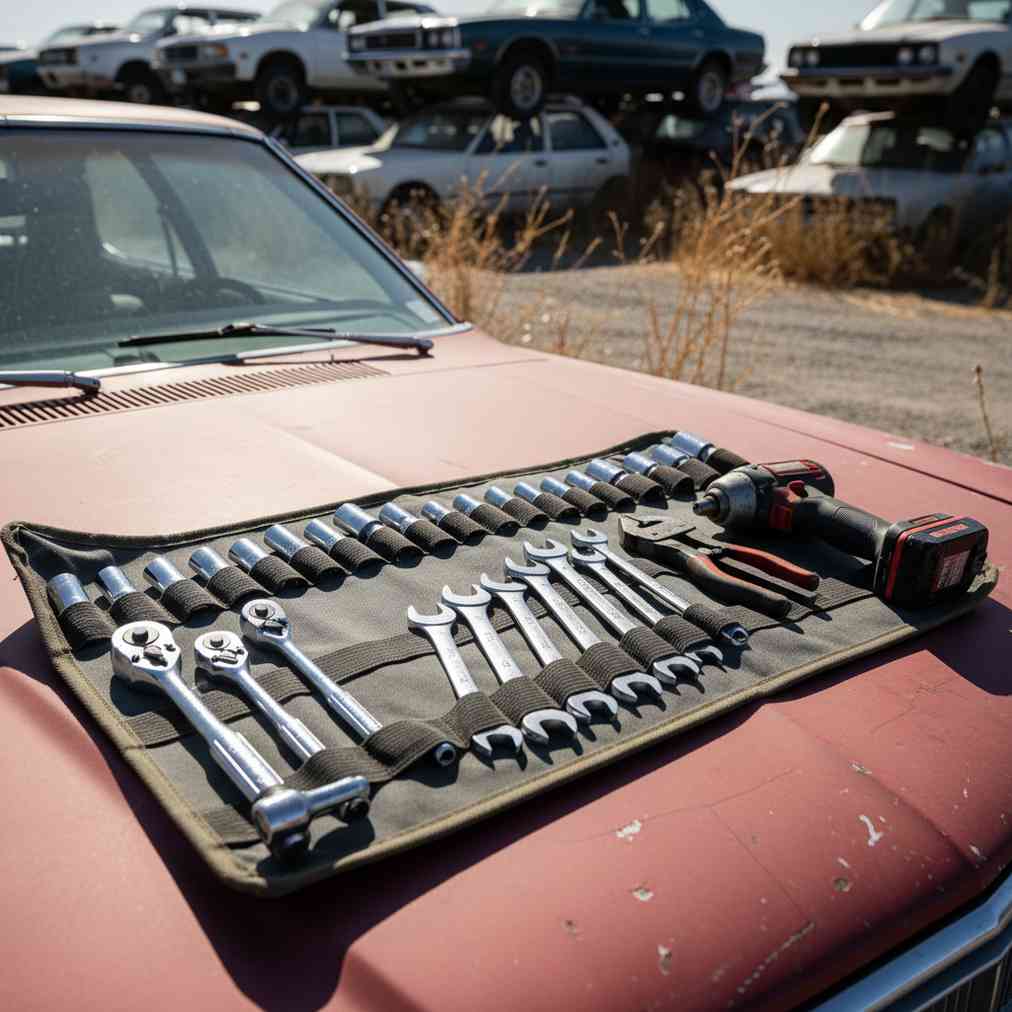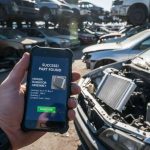Understanding the Purpose of a Portable Junkyard Tool Kit
When venturing into a junkyard near you, having the right portable tool kit can make the difference between a successful parts-pulling mission and a frustrating waste of time. The primary goal of any junkyard tool bag is achieving versatility and efficiency while keeping weight and bulk to a minimum, as salvage yard visits often require walking significant distances across uneven terrain.
Unlike your home garage where premium tools reign supreme, junkyard tools should be of good, but not heirloom, quality. The rough environment means tools are likely to be lost, damaged, or subjected to harsh conditions including dirt, grease, and weather exposure. Some experienced salvagers even prefer a tool backpack over traditional bags to keep both hands free for carrying valuable parts back to their vehicle.
Essential Knowledge: Understanding Fastener Systems
Success at any salvage yard hinges on having the right sockets and wrenches for your target vehicle’s country of origin. Modern vehicles use a complex mix of fastener standards that can frustrate even experienced mechanics without proper preparation.
Metric Fasteners (Asian and Modern European Vehicles)
Asian manufacturers and many modern vehicles rely heavily on metric fasteners. The most common sizes you’ll encounter include:
- 12mm – Frequently used for smaller brackets and trim pieces
- 14mm – Common for suspension parts and engine accessories
- 17mm – Standard for wheel lugs on many vehicles
- 19mm – Often found on larger suspension and drivetrain parts
SAE (Standard) Fasteners (American Vehicles)
American manufacturers traditionally use SAE fasteners, though many have transitioned to metric systems. Key sizes include:
- 13mm, 15mm, 18mm, and 19mm bolts for various applications
- Common SAE bolt diameters starting at 1/4″ and progressing upward
- 3/8″ and 7/16″ frequently used for body panels and trim
Specialty Fasteners
Torx screws have become increasingly common, especially on interior trim and body panels. Additionally, JIS (Japanese Industrial Standard) screwdrivers are essential for certain Japanese fasteners, as they prevent the frustrating stripping that occurs when using standard Phillips head drivers on JIS screws.
Modern Considerations for Today’s Salvage Operations
The salvage yard landscape has evolved significantly with technological advances. Modern salvage operations now incorporate sophisticated inventory systems and updated safety protocols that smart salvagers can leverage for better results.
Power Tools Revolution
Cordless impact drivers or ratchets have revolutionized junkyard efficiency, especially when dealing with suspension parts or large, rusted bolts. However, always verify that your target yard allows power tools before bringing them. Some facilities restrict their use for safety or noise considerations.
Specialized Modern Tools
Today’s vehicles require specific tools that weren’t necessary decades ago. Essential modern additions include:
- Fuel Line Disconnect Tool Sets for modern quick-connect fittings
- Automotive Trim Removal Tool Kits featuring plastic pry tools to avoid damaging brittle plastic tabs
- Comprehensive Torx bit sets for various screw applications
The Complete Portable Junkyard Tool Kit Checklist
Building the perfect junkyard tool kit requires balancing comprehensive capability with portable practicality. The following breakdown categorizes tools by necessity and utility for maximum salvage efficiency.
Absolute Essentials: Must-Have Tools for Every Trip
| Tool Category | Specific Requirements |
|---|---|
| Sockets & Ratchets | Comprehensive 1/4″ and 3/8″ drive sets in both SAE and Metric, including deep sockets and extensions |
| Wrenches | SAE and Metric combination or ratcheting wrenches, plus one small adjustable wrench |
| Pry Bar | Multiple sizes for leverage on rusted or tightly fitted parts |
| Screwdrivers | Phillips, Flathead, and JIS varieties with magnetic tips preferred |
| Pliers | Needle-nose, channel locks, and locking pliers (Vise-Grips) |
| Cutting Tools | Sharp utility knife or multi-tool for wires, hoses, and trim |
| Safety Equipment | Durable work gloves, safety glasses, plastic bags for hardware, permanent marker |
Pro-Level Additions: Advanced Efficiency Tools
| Tool Category | Professional Specifications |
|---|---|
| Power Tools | Cordless Impact Driver/Ratchet with extra charged batteries |
| Specialty Hand Tools | Fuel Line Disconnect Tool Set, Automotive Trim Removal Kit, Folding Torx tools |
| Electrical Testing | Small multimeter or 9V battery for relay testing, penlight or headlamp |
| Enhanced Leverage | Breaker bar (typically 1/2″ drive), copper pipe for makeshift leverage |
| Chemicals & Cleaning | Penetrating fluid (PB Blaster), hand sanitizer, heavy-duty hand cleaner |
Strategic Organization for Maximum Efficiency
Proper organization prevents tool loss and ensures quick access during time-sensitive operations. As data analysis shows, organized systems significantly improve task completion rates across various industries, and salvage operations are no exception.
Choosing the Right Carrier
Select a lightweight, durable fabric bag with zipper closure rather than heavy hard-sided boxes. Many yards restrict or ban hard cases, and fabric bags offer superior portability. Tool backpacks represent an excellent alternative, freeing both hands for part transportation and providing better weight distribution during long walks across the yard.
Internal Organization Systems
- Socket Rails and Tool Rolls: Keep sockets organized on rails to prevent scattering. Store wrenches neatly in tool rolls for quick identification and access.
- Exterior Pockets: Reserve these for high-use tools including primary ratchets, frequently used screwdrivers, and penetrating fluids.
- Zippered Pouches: Use internal mesh bags or pouches for small, loose items like specialty bits, fuses, zip ties, and small hardware.
- Main Compartment: Store heavier or bulkier items like breaker bars, power tools, and trim tool kits upright in the center for balanced weight distribution.
Maintenance and Organization Best Practices
“Clean-as-you-go routines prevent dirt and grime accumulation inside the bag, maintaining organization and extending tool longevity.”
Implement these organizational strategies for sustained efficiency:
- Immediate cleaning: Wipe down tools before returning them to prevent contamination
- Label everything: Always label bags containing removed nuts and bolts immediately
- Inventory checks: Conduct quick tool counts before leaving each vehicle
- Weather protection: Keep tools dry and protected from moisture
Advanced Strategies for Professional Results
Experienced salvagers employ sophisticated techniques that maximize both efficiency and success rates. Research indicates that systematic approaches yield consistently better outcomes in complex operational environments.
Vehicle-Specific Preparation
Before visiting any salvage yard, research your target vehicle’s specific requirements. Different manufacturers use distinct fastener patterns, and knowing these in advance prevents frustrating discoveries mid-project. Japanese vehicles often require JIS screwdrivers, while German cars may use specialized Torx variants.
Time Management and Planning
Successful junkyard visits require strategic planning beyond tool selection. Consider factors such as:
- Weather conditions affecting tool performance and safety
- Yard operating hours and peak busy periods
- Seasonal inventory variations based on local driving patterns
- Part availability research using online inventory systems when available
Safety Considerations and Legal Compliance
Modern salvage operations prioritize safety and environmental compliance. Your tool kit should reflect these priorities while ensuring personal protection during parts removal activities.
Personal Protective Equipment
- Cut-resistant gloves for handling sharp metal edges
- Safety glasses with side shields for eye protection during cutting operations
- Steel-toed boots for foot protection from falling parts
- Long pants and sleeves to prevent cuts and scrapes
Environmental Responsibility
Include tools and supplies for proper fluid handling and environmental protection. This demonstrates professionalism and ensures compliance with yard regulations. Consider bringing absorbent materials for fluid spills and proper containers for any fluids you might encounter during parts removal.
Economic Considerations and ROI
Building an effective junkyard tool kit requires investment, but the returns through successful parts acquisition make it worthwhile. Economic analysis demonstrates that well-equipped salvagers achieve significantly better cost-per-part ratios than those using inadequate tools.
Cost-Benefit Analysis
Consider the total cost of ownership when selecting tools. Slightly more expensive tools that survive longer in harsh conditions often provide better value than frequently replaced cheaper alternatives. However, avoid premium tools that represent significant loss if damaged or stolen.
Tool Replacement Strategy
Develop a systematic approach to tool replacement and upgrades. Keep spare essential tools at home, and consider seasonal tool maintenance to ensure peak performance when needed most. If you’re looking to sell your junk car for cash, remember that having the right tools can help you remove valuable parts first, maximizing your total return.
Technology Integration and Modern Enhancements
Today’s salvage operations benefit from technological integration that enhances traditional tool functionality. Modern approaches to parts identification and inventory management can significantly improve your success rate.
Digital Tools and Apps
- VIN decoder apps for parts compatibility verification
- Torque specification databases for proper fastener handling
- Part identification guides using photo recognition
- Inventory tracking apps for multi-yard part searches
Power Management
For power tool users, battery management becomes crucial for sustained operations. Consider portable charging solutions and maintain multiple battery packs to avoid mid-job power loss. Some advanced salvagers use solar chargers or portable power stations for extended yard sessions.
Conclusion: Building Your Perfect Go-Bag
Creating the perfect portable junkyard tool kit requires balancing comprehensive capability with practical portability. Start with the essential tools outlined in this guide, then gradually add professional-level additions based on your specific needs and experience level.
Remember that organization is equally important as tool selection. A well-organized, efficiently packed tool bag can make the difference between a successful parts-pulling mission and a frustrating experience. Regular maintenance, strategic planning, and continuous refinement of your kit will ensure optimal performance across diverse salvage scenarios.
Whether you’re a weekend warrior seeking affordable repairs or a professional rebuilder, the right portable tool kit opens doors to unlimited possibilities in the fascinating world of automotive salvage. Start building your perfect go-bag today, and transform every junkyard visit into a successful treasure hunt.





Leave a Reply
You must be logged in to post a comment.